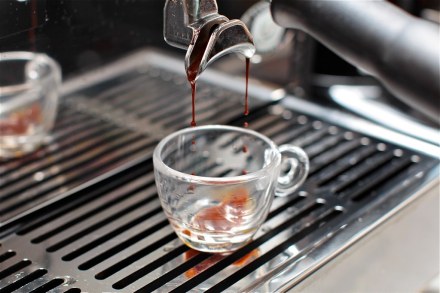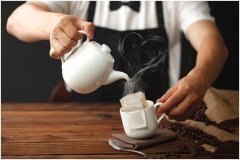The fat of Espresso seems simple, but it is worth studying!

Many friends who are using coffee utensils other than Italian machines always struggle with the fact that their coffee is free of oil. Only coffee made by Italian machine has fat?! Why does the mocha pot have so little espresso oil?! What kind of grease can be regarded as the perfect Espressofan!
If we want to talk about grease, let's look at it from these two aspects. First, let's take a look at what's in a cup of black coffee besides water: caramelized sugars, flavored oils, quinic acid, and caffeine. If there is no flavor oil in the coffee, then there is no difference between stir-fried coffee and stir-fried corn (there is also oil in old corn). That is to say, it is decided that each cup of coffee from different producing areas has different taste mainly because of the difference of flavor oil. As a result, the taste of coffee becomes colorful and fascinating.
The grease of ESPRESSO is not really a layer of "oil" floating on the surface of coffee, but is composed of delicate bubbles, so when we study the thickness of grease, we should not only look at how thick it is, but also observe how long it can last. The thickness of oil generally has a lot to do with the freshness of beans. If the beans are too fresh, the extracted oil will be very thick, but it will dissipate very quickly. We think that this kind of oil is too rough. Therefore, bean cultivation plays an irreplaceable role in the formation of oil. Only beans raised correctly can extract long-lasting oil. Although the fat is too thick is not necessarily a good thing, but if the oil is too thin, it must be a bad thing, generally due to: beans stored for too long or improper preservation; too little powder; grinding too coarse or too fine; extraction time is too long or too short; the flow rate is too large; improper filling pressure and other reasons.
Why does the state of grease have an effect on flower drawing? The state of different oils is actually equivalent to different liquid viscosity. If chocolate sauce is added to Espresso, the purpose is to increase the viscosity of Espresso. The thicker the liquid, the greater the fluidity of the liquid. When drawing flowers, using the same size of water injection, the better the state of Espresso, the higher the viscosity, the greater the fluidity of the liquid, and the clearer the lines of the pattern.
How to control the state of grease?
1. The Espresso cannot be placed for more than 30 seconds after the production is completed. If the Espresso is placed for too long, the grease and liquid will be delaminated. To do this, we need to form the good habit of pouring milk into the milk tank first, then extracting Espresso and whipping away at the same time.
2. Coffee beans must be fresh. If the coffee beans are stored for too long and are not fresh, the fat of Espresso will be very thin.
3. Freshly baked coffee beans need to be nourished. For freshly baked coffee beans, if they are not nourished, there will be too much carbon dioxide inside the coffee beans, and there will be obvious rough bubbles in the fat of Espresso.
The color of Italian caffeine oil can well reflect whether the extraction degree of ESPRESSO is moderate, whether the powder is enough, whether the filling force is in place, whether the water temperature of the coffee machine is correct and whether the beans are fresh and many other factors. The color of Italian coffee oil is preferably golden yellow and slightly brown, and the color of oil is milky white, which is generally called underextraction, while the preference for dark brown is excessive extraction.
Insufficient extraction
The lack of extraction is generally reflected in the milky white color of the oil, which may be due to insufficient powder, too light filling force, too low water temperature, too coarse coffee powder, insufficient water pressure or not fresh coffee beans. sometimes it is also related to the light roasting of coffee beans or the variety of coffee beans.
Excessive extraction
Excessive extraction is generally reflected in the dark brown color of the oil, which may be caused by too much powder, too much filling force, too high water temperature, too fine grinding of coffee powder and other reasons, sometimes it has something to do with the excessive roasting of coffee beans. The grease color of espresso is the most basic knowledge that coffee lovers and baristas must understand and master, which can help you understand the quality of coffee in the shortest possible time.
Is coffee made from a mocha pot Italian? Italian is a way of extraction, and it can be regarded as Italian if you can't see the fat. But in fact, the grease is in the mocha pot, and there is an old-fashioned mocha pot with a thin curved tube on the bottom seat, and the coffee is made with golden grease like the Ruyi machine.
So do drip coffee machines, French presses, siphon pots, and hand-brewed coffee have any oil? For example, when the coffee is soaked, or even when the filter plug is pressed down, is the layer on top of the coffee in the pot considered grease? That's a layer of foam, but that's that the coffee fat is just rough.
We say that the coffee oil made by Italian mechanism is obvious and satisfying in coffee, which is determined by the method and principle of extraction. This method makes the coffee flavor oil dense and can stand in the cup for a long time, while the mocha kettle has high water temperature and insufficient pressure, even if there is grease, but it is not easy to stand for long. So he poured it into the cup and disappeared.
Drip coffee machines, siphon pots, manual brewing utensils and even pressure are extracted without pressure. For example, when the coffee liquid flows from the upper seat to the lower seat near the end of the siphon pot, the foam on the top of the coffee liquid is also the fat of coffee. It's just that this kind of grease is rough and loose and is not easy to detect in the cup.
Grease is a seemingly simple but worth exploring step in the whole process of making Espresso.
Part of the material comes from the Internet, the country of coffee revised editor, reprint please indicate the source!
Important Notice :
前街咖啡 FrontStreet Coffee has moved to new addredd:
FrontStreet Coffee Address: 315,Donghua East Road,GuangZhou
Tel:020 38364473
- Prev

The latest processing method of green coffee beans introduces red wine making skills
In the championship competition, contestants had to prepare four espresso, four cappuccinos and four creative coffees in 15 minutes, and Sasa Sestic's creative coffee borrowed from red wine making techniques and won the judges 'hearts. Carbon dioxide maceration is a method of fermenting grapes in sealed containers filled with carbon dioxide. WBC World Coffee 2015
- Next

What are the professional requirements for working as a barista
Emerging jobs in the 21st century service industry the Ministry of Labor and Social Security established 12 new occupations in 2006, among which baristas are quite eye-catching, because a good barista makes not only a cup of coffee, but also a coffee culture. So, what is a barista? What talents does a barista need to have? Barista career description barista refers to being familiar with coffee
Related
- What is the meaning of lactic acid fermentation with coffee bean treatment?
- How to judge the state of foam by sound?
- How does the latte pull out the unicorn pattern? Come to get for a little trick to improve the flower pull!
- Will flower pulling affect the taste of the latte?
- Do you know the history of coffee?
- The difference between honey treatment and sun washing what is raisin honey treatment?
- What kind of milk can a novice use to make coffee foam to keep the foam longer? The correct method and skills of milking tutorial sharing
- Why do washed coffee beans taste sour? Flavor characteristics of washed Coffee
- Introduction to the skill of how to practice the size and height of water injection around the circle of hand-brewed coffee
- How do beginners practice coffee flower drawing from scratch?

